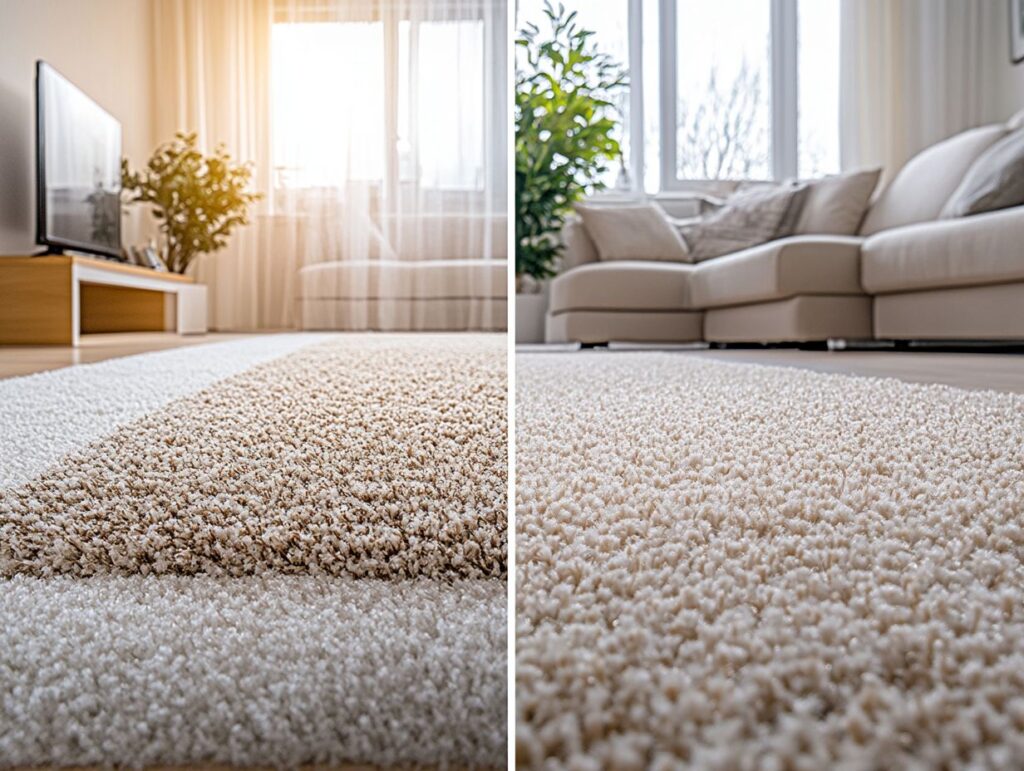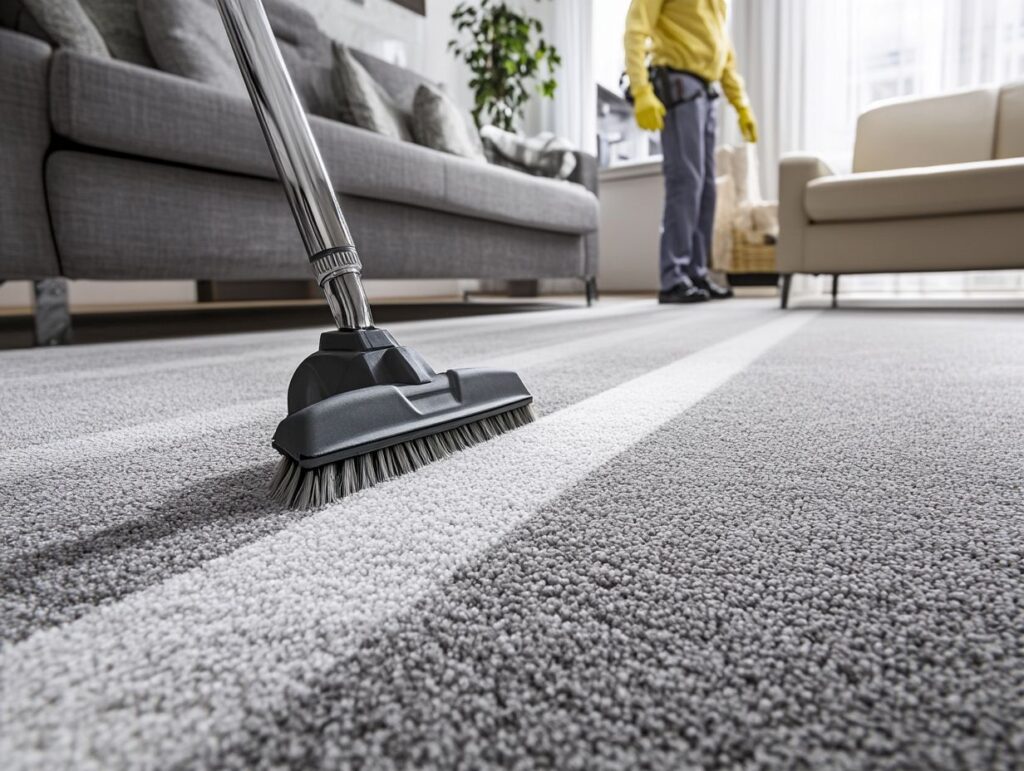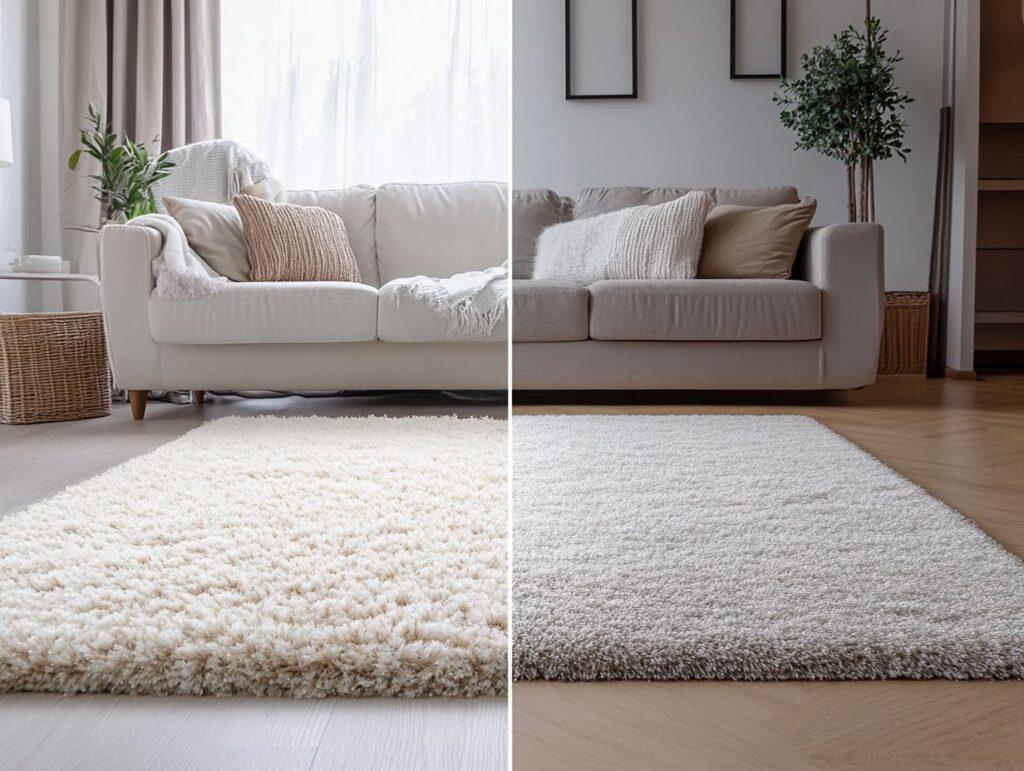Nylon carpets are popular for their durability and good looks, but keeping them clean can be challenging.
Let’s examine the two most common cleaning methods: hot water extraction and dry cleaning. Each method has unique processes and benefits, along with factors you should consider based on the type of stains and the condition of your carpet.
Take some time to weigh the pros and cons of both methods to determine the best option for maintaining the beauty and longevity of your nylon carpets.

Nylon Carpets At A Glance
Nylon carpets are some of the most versatile and popular flooring options, whether you’re decorating a home or a commercial space. They’re known for their durability and vibrant colours that brighten a room.
These carpets have incredible fibre characteristics, like high tensile strength and resistance to crushing, plus they come in a variety of styles to match your design preferences. From plush and tufted options to loop pile styles, nylon carpets allow you to create welcoming and functional spaces no matter where you are.
You can’t underestimate the importance of reputable carpet manufacturers in ensuring quality and performance in your flooring. Plus, keeping your carpet looking fresh is a breeze with regular maintenance—just a bit of vacuuming and quick stain treatment can go a long way. This makes nylon carpets an excellent long-term investment for your space.
Hot Water Extraction for Nylon Carpets
Hot water extraction is one of the best ways to keep your nylon carpets looking fresh and lasting longer. This method, often called steam cleaning, uses heated water mixed with cleaning solutions to penetrate the carpet fibres, tackling dirt, allergens, and stubborn stains that seem to settle in over time.
Hot water helps lift the grime and improves indoor air quality by removing allergens trapped in the carpet. Once you have finished cleaning, don’t forget that drying time is crucial in preventing moisture build-up and potential mould growth.
Process and Benefits
Hot water extraction for your nylon carpets involves a few key steps that ensure they receive a thorough cleaning and come out looking and smelling fresh.
- First, you should pre-treat the carpet with a suitable cleaning solution that targets dirt and pesky pet stains. This will help the cleaning agents work their magic.
- Next, hot water is injected into the carpet fibres, loosening up deep-seated grime and odours.
- Once the cleaning is done, powerful suction equipment whisks away the water and dirt, which means minimal drying time and maximum freshness for your carpets.
This method not only spruces up the appearance of your carpets but also helps improve indoor air quality. Hot water extraction promotes a healthier living environment by effectively removing allergens, dust mites, and bacteria trapped in the fibres.
This process’s moisture retention capabilities allow the cleaning agents to penetrate deeply, ensuring stubborn stains are completely eradicated, not just masked.
When you combine high-temperature water with specially formulated cleaning solutions, you maximise cleaning effectiveness. Even those challenging marks don’t stand a chance, giving any carpeted area a brand-new lease of life.

Dry Cleaning for Nylon Carpets
Dry cleaning is an excellent option for cleaning nylon carpets, especially regarding moisture retention. It allows for a quick turnaround without those long drying times.
This method uses specialised cleaning products that soak up dirt and stains, which you can easily vacuum away. It’s incredibly convenient perfect for busy households or commercial spaces.
Furthermore, dry cleaning is very effective for keeping your carpet looking sharp and extending its lifespan since it reduces the risk of water damage while helping to maintain the carpet’s texture and colour.
Process and Effectiveness
The dry cleaning process for your nylon carpets is all about using a solvent-based cleaning agent that effectively targets stains without saturating your carpets in moisture. First, you’ll want to vacuum the carpet to remove any surface dirt. Then, you apply those dry cleaning products that bond with the soil particles. After allowing the cleaning agents to work their magic on the fibres, you vacuum again to remove the dirt and residue. This way, your carpet stays stain-resistant and looks sharp, all while maintaining the indoor air quality.
Proper technique is critical to achieving the best cleaning results in this detailed process. Each type of stain—from food to drinks to oils—requires a specific approach and cleaning agent designed just for it. Choosing a solvent compatible with nylon fibres is essential to avoid causing any damage while still removing those stains. You’re maximising cleaning effectiveness when trained professionals monitor the process, ensuring the cleaners have the perfect dwell time.
Regular dry cleaning not only helps extend the life of your carpet but also keeps your home feeling fresh and welcoming.

Factors to Consider When Choosing a Cleaning Method
When selecting the right cleaning method for your nylon carpets, consider a few factors that can really impact the effectiveness of hot water extraction or dry cleaning.
First, consider the condition of your carpet. If it is heavily soiled or stained, consider deep cleaning techniques. If it is dirty, regular maintenance could do the job.
Also, consider factors such as traffic patterns on the carpet, any allergens present, and your sensitivities to chemicals. These factors can help you make a decision that balances effective cleaning with the overall health of your indoor environment.
Type of Stains and Carpet Condition
Understanding the type of stains and the condition of your nylon carpet is critical to determining the best cleaning method.
Nylon carpets are tough and resilient, but they can still attract all sorts of stains that threaten their good looks and lifespan. You’ve probably dealt with common culprits like food spills from sauces and drinks, pet accidents, or dirt from shoes. Each of these presents its own set of challenges. For instance, if you’re facing oil-based food stains, you’ll want to grab a degreasing agent to break down those residues. And for pet stains, enzymatic cleaners are your best bet since they target the odour-causing bacteria.
Remember that routine maintenance matters, too. Regular vacuuming to remove dirt and debris can significantly extend your carpet’s life. Understanding these little details makes stain removal easier and keeps your carpet’s integrity intact.
Pros and Cons of Hot Water Extraction and Dry Cleaning
When weighing the pros and cons of hot water extraction versus dry cleaning for your nylon carpets, consider how well each method cleans and how much it costs.
Hot water extraction is like the superhero of carpet cleaning—it goes deep to remove dirt, allergens, and stubborn stains, making it the go-to choice for a thorough clean. Just remember that it might take longer to dry and can incur higher equipment costs.
On the other hand, dry cleaning is all about speed; it dries quickly and is great for routine maintenance. But, it might not delve as deeply into the carpet fibres as hot water extraction does.
Comparing Effectiveness and Cost
When you compare the effectiveness and costs of hot water extraction and dry cleaning, you uncover valuable insights for choosing the correct cleaning method for your nylon carpets. Hot water extraction usually provides:
- Superior cleaning power.
- Effectively removing dirt and allergens.
- Boosting indoor air quality and keeping carpets fresh.
However, choosing the professional route tends to come with higher service costs.
On the flip side, dry cleaning is often more budget-friendly and has the advantage of quicker drying times. Still, you should maintain those carpets more frequently, especially in high-traffic areas, to keep them looking smart.
Ultimately, your decision should consider not just the immediate costs but also the long-term durability of your carpets and the maintenance commitment you are willing to make. While professional hot water extraction services might hit your wallet harder at first, they can extend the life of your carpets, which means fewer replacements down the line.
With DIY dry cleaning solutions on the rise, you can balance cost and effectiveness by paying regular attention to your carpets. Just remember that misusing cleaning agents could lead to long-term damage. So, weighing these factors will help you make an informed choice that keeps your flooring looking beautiful and lasting longer.